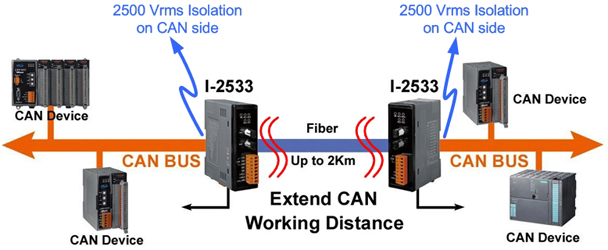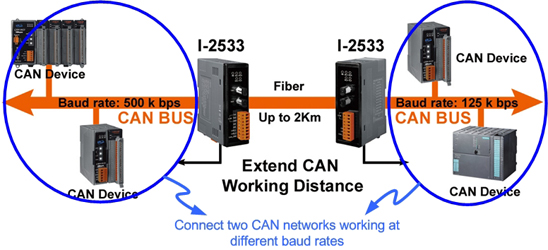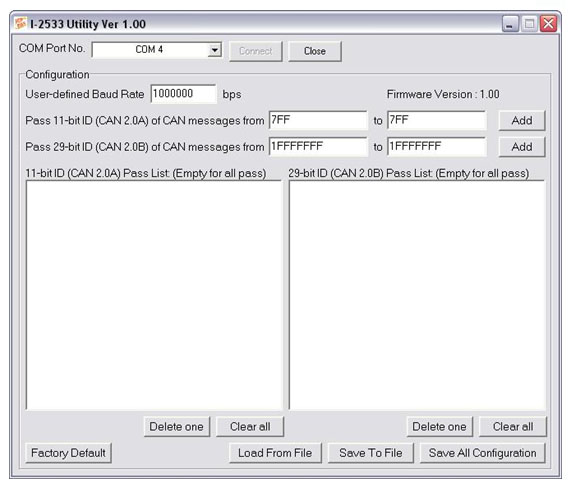 |
|||||||
| ICP DAS New Product¡GI-2533 CAN to Fiber Bridge | ||||||||||||||||||||||||||||||||||||||||||||||||||||||||||||||
 |
||||||||||||||||||||||||||||||||||||||||||||||||||||||||||||||
The I-2533 is a local CAN bridge used to establish a connection between two CAN bus systems via fiber transmission medium. In order to solve the problem between CAN and fiber transmission mediums, the I-2533 is specially designed for converting the electrical CAN bus signal to the optical signal, and recover the signal to CAN bus by using another I-2533. Compare with the I-2532, CAN to fiber converter, the I-2533 has three more important features. First, the transmission distance limitation of the CAN bus system will not be reduced due to higher CAN baud rate. No matter what kind of CAN baud rates you use, the data transmission distance of fiber is up to 2 km. It means that the total network working distance can be extended. |
||||||||||||||||||||||||||||||||||||||||||||||||||||||||||||||
 |
||||||||||||||||||||||||||||||||||||||||||||||||||||||||||||||
Second, the error on the CAN bus side of the I-2533 will not affect the normal operation of the side on the fiber optic cable. Finally, you can use different baud rate in the CAN networks located at the both ends of the fiber optical cable if necessary. |
||||||||||||||||||||||||||||||||||||||||||||||||||||||||||||||
 |
||||||||||||||||||||||||||||||||||||||||||||||||||||||||||||||
Besides, the I-2533 provides the utility tool for user-defined baud rate and message filter configuration. When users use the I-2533 on two CAN networks which have different CAN baud rate, it may be useful to reduce the bus loading on the network. |
||||||||||||||||||||||||||||||||||||||||||||||||||||||||||||||
 |
||||||||||||||||||||||||||||||||||||||||||||||||||||||||||||||
The following table describes the performance test of the I-2533. The test architecture uses two I-2533s connected with a two-meter fiber optic cable. The CAN port of each I-2533 connects a CAN device which is programmed to send 100,000 ID-fixed 2.0A CAN messages with each other. Record the time interval between the time of start transmission and the time which the CAN device has received 100,000 2.0A CAN messages sent from another CAN device. |
||||||||||||||||||||||||||||||||||||||||||||||||||||||||||||||
|
||||||||||||||||||||||||||||||||||||||||||||||||||||||||||||||
| Note: FPS stands for frame per second. | ||||||||||||||||||||||||||||||||||||||||||||||||||||||||||||||
Features:
|
||||||||||||||||||||||||||||||||||||||||||||||||||||||||||||||
| Comparison Table of CAN Repeater & Bridge Products: | ||||||||||||||||||||||||||||||||||||||||||||||||||||||||||||||
|
||||||||||||||||||||||||||||||||||||||||||||||||||||||||||||||
| For more information about the products described above, please refer to the following website: I-2532: http://www.icpdas.com/products/Remote_IO/can_bus/i-2532.htm I-2533: http://www.icpdas.com/products/Remote_IO/can_bus/i-2533.htm I-7531: http://www.icpdas.com/products/Remote_IO/can_bus/i-7531.htm I-7532: http://www.icpdas.com/products/Remote_IO/can_bus/i-7532.htm |
||||||||||||||||||||||||||||||||||||||||||||||||||||||||||||||
| back | ||||||||||||||||||||||||||||||||||||||||||||||||||||||||||||||